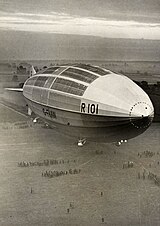George Herbert Scott
George Herbert Scott , Lucky Breeze Scott CBE AFC (born May 25, 1888 in Lewisham , London, † October 5, 1930 at Allonne (Oise) in northern France) was a British aviation pioneer , airship pilot and engineer. As a major of the Royal Naval Air Service and the Royal Air Force , he completed the first non-stop flight with the airship R34 - crossing the Atlantic with an airship.
Life


Family, education and work
Scott was the eldest son of engineer George Hal Scott. He attended the Plymouth School , the Richmond School in North Yorkshire and the Royal Naval Engineering College at Plymouth-Keyham to train a marine engineer.
Scott joined the Royal Naval Air Service in 1914 . He became a flying officer (first lieutenant ) of the aviators and drove a Parseval airship from 1913 from 1914. Then he received command of the RAF station Anglesey . In April 1917 he became the captain of the first rigid airship No. 9r at the RAF station at Howden , Yorkshire . He then drove the same ship at RAF Cranwell Station in Lincolnshire and RAF Pulham Station in Norfolk . In April 1918 he was promoted to major .
First trip to the Atlantic
On July 2, 1919, under the command of Scott, the R34 took off from East Fortune in East Lothian / Scotland for the first non-stop Atlantic crossing of a rigid airship . The airship reached Mineola / New York ( Long Island ) on July 6, 1919. The outward journey took 108 hours and 12 minutes. The return trip to Norfolk , England began on July 9, 1919 and only took 75 hours and 3 minutes due to the wind conditions. There were 33 people on board. It was not until 1924 that the Zeppelin LZ 126 was the next airship to cross the Atlantic.
Aviation pioneer and engineer
In 1919 Scott finished his military service and in 1920 he became a technical assistant at the Royal Airship Works in Cardington, Bedfordshire . At Pulham he researched as chief engineer a. a. Airship anchorages and their first tall masts that were up to 37 meters high. Together with the designer Vincent Richmond, he contributed to the design of the airships, including the construction of the R100 and R101 and the R36 for high-speed tests.
Crash and death
After a successful R100 trip to Canada, attention turned to an R101 flight to India. A necessary extension of the airship was completed in 1930.
A test flight before the trip to India began on the evening of October 1st and should last 16 hours. The R101 flight was with Scott and 53 other people on board. However, conditions were stormy over northern France. Over Allonne , Oise near Beauvais, R101 caught fire on the night of October 4th to 5th, 1930 due to gas losses. Scott and 45 others were killed instantly, with two others dying from their injuries; there were only six survivors. Among the dead were the then British Aviation Minister Lord Thomson and the designer of the airship Vincent Richmond. At the state funeral of the victims, Hugo Eckener and Hans von Schiller were also present as representatives of the German airshipmen.
The Dictionary of National Biography described him "without a doubt the most important British airship commander of his time". But he was also criticized, u. a. by Peter Masefield for underestimating the risk of a storm on the last flight of the R101.
Scott was married and the couple had four children. He lies with the other victims in a shared grave in the cemetery of St. Mary the Virgin in Cardington.
Honors
- Order of the British Empire
- Air Force Cross (AFC)
- In Bremen on Böttcherstrasse , ten rotating wooden panels of well-known ocean conquerors are depicted at the Haus des Glockenspiels , including Scott together with the British Arthur Whitten Brown and John Alcock , who made the first non-stop flight across the Atlantic in 1919.
literature
- Scott, George Herbert (1888–1930) In: Dictionary of National Biography . Oxford University Press.
- Peter G. Masefield: To Ride the Storm: The Story of the Airship R.101 , William Kimber, London 1982, ISBN 0-7183-0068-8 .
- John Swinfield: Airship: Design, Development and Disaster . Conway, London 2012, ISBN 978-1-84486-138-5 .
Web links
- R34 - The Record Breaker . The Airship Heritage Trust
- R101 . The Airship Heritage Trust
Individual evidence
- ^ HA Jones: Scott, George Herbert (1888-1930). In: Dictionary of National Biography , Oxford University Press.
- ^ Peter Masefield: To Ride the Storm: The Story of the Airship R.101 . Masefield also cited a number of landing accidents with Scott
| personal data | |
|---|---|
| SURNAME | Scott, George Herbert |
| ALTERNATIVE NAMES | Scott, George Herbert Lucky Breeze |
| BRIEF DESCRIPTION | British aviation pioneer, engineer and officer |
| DATE OF BIRTH | May 25, 1888 |
| PLACE OF BIRTH | Lewisham |
| DATE OF DEATH | 5th October 1930 |
| Place of death | Allonne (Oise) |
